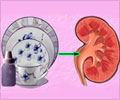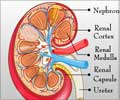In patients with end-stage kidney disease, a new testing method can better detect potentially fatal hormone imbalances.

At the end of 2009, more than 871,000 Americans were being treated for end-stage renal disease, according to the National Institutes of Health's National Institute of Diabetes and Digestive and Kidney Diseases (NIDDK). These patients require dialysis or kidney transplants to stay alive. About 10 to 20 percent of patients with chronic kidney disease stage 5, or end-stage renal disease, die each year.
One key factor that contributes to the risk of death in this population is levels of parathyroid hormone, the hormone that makes calcium available in the blood for important body functions. When parathyroid hormone levels are too low or too high, it raises the mortality risk for patients with end-stage renal disease.
"The current tests for parathyroid hormone levels overlook a key factor," said the study's lead author, Berthod Hocher, MD, PhD, of the University of Potsdam in Potsdam-Rehbrücke, Germany. "When parathyroid hormone interacts with oxygen under conditions of stress such as end-stage kidney disease, it becomes biologically inactive. Our new approach is the first to differentiate between non-oxidized, biologically active parathyroid hormone and oxidized parathyroid hormone. This will result in better monitoring and treatment for patients who have end-stage renal disease."
Researchers conducted a prospective cohort study to test this approach. The study authors monitored a group of 340 dialysis patients over the course of a five-year period. Researchers tested blood samples from the patients to determine their parathyroid hormone levels. During the course of the follow-up period, 170 participants died, many from cardiovascular disease, infections or cancer.
The patients who survived had higher median levels of non-oxidized parathyroid hormone than the study participants who died. The study found an increased rate of survival among dialysis patients who had the highest levels of non-oxidized parathyroid hormone.
Advertisement
Source-Eurekalert











